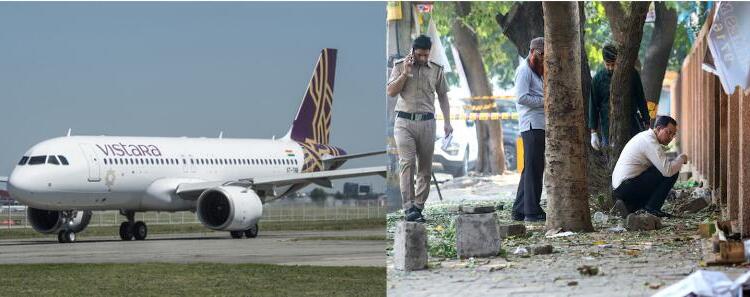The pattern of hoax bomb threats directed at the Indian airlines continued for the fifth consecutive day and today a blast was reported outside the CRPF school in the Prashant Vihar area of Rohini district. Now the bigger question arises, are these two stories somewhere connected to each other. There is a need to conduct a serious investigation to find a link between the continuous threats of bomb blast and the blast that took place today outside the CRPF school.
Hoax Bomb Threats
Over 30 flights from Indian airlines, including Vistara, Air India, and IndiGo were hit by hoax bomb threats on the 19th of October. The Airlines that suffered the hoax threats included Air India, IndiGo, Akasa Air, Vistara, SpiceJet, Star Air, and Alliance Air.
With 30 flight threats on 19th October, the sum of total hoax threats have reached a total of 70 this week which is concerning for the country. Most of these threats have been given through social media out of which most of them turned out to be fake, while in one case, a note was spotted in a flight’s lavatory that claimed that the flight had a bomb.
Rohini Blast
In the morning of 20th October, in the Prashant Vihar area of Rohini district a blast was reported outside the CRPF school. Following the blast, the Forensic Science Laboratory and bomb disposal squad were dispatched to investigate the cause. The blast caused no injuries but the school wall,nearby shop windows, and a parked car got damaged because of the blast.
In the aftermath of the incident, nearby police stations have been put on alert, with increased vigilance and checks in place. “Foot patrols have been intensified across various markets. We urge the public to immediately notify the police if they encounter any suspicious items,” stated another senior official.
Why are hoax threats a big concern for the county?
Hoax threats are nothing that can be taken lightly. The alarming increase in fake bomb threats across the country is indeed a significant cause for concern. Such a surge not only burdens our security forces but also creates a false sense of immunity against genuine threats. When the majority of these threats are ultimately revealed to be hoaxes, it can desensitize both the public and security personnel, making them less vigilant in the face of real dangers. This phenomenon undermines the seriousness of security protocols and could potentially lead to catastrophic consequences if a legitimate threat arises while resources are diverted to address fabricated emergencies.
Furthermore, we must also consider the rising incidence of train sabotages, which adds another layer of complexity to the national security landscape. If these incidents are strategically planned, they could serve as a deliberate attempt to assess the effectiveness of our security response mechanisms. Such a tactic would aim to exploit vulnerabilities in our system, particularly on days when our security apparatus is already stretched thin due to responding to numerous false alarms. This scenario poses a grave risk, as it could allow genuine threats to go unnoticed and unaddressed. Also the hoax bomb threats take a heavy toll on logistics and operational costs. Continuous threats are a big issue that needs to be resolved soon.
Islamist plan to target India’s transportation system
Farhatullah Ghori, Pakistan-based Islamic terrorist, released a video a couple of months ago on Telegram urging his supporters to carry out large-scale train derailments in major Indian cities such as Delhi and Mumbai. In the video, Ghori incites jihadists to disrupt India’s railway lines and transportation systems, claiming that such acts would create widespread chaos across the country.
Ghori, who is on the intelligence establishment’s most wanted list, made inflammatory statements, saying, “The government is targeting our properties through agencies like the ED and NIA, but we will remain resolute. Sooner or later, we will seize power.” His message was a clear call for terror activities aimed at undermining India’s infrastructure






























